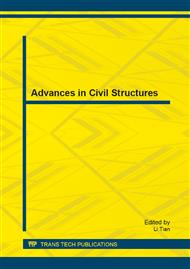p.1028
p.1034
p.1038
p.1043
p.1047
p.1052
p.1057
p.1061
p.1066
Seismic Time-History Analysis of Gravity Dam Based on Nonlinear Finite Element Method
Abstract:
A cohesive model (CM) was introduced in this paper. The constitutive response of cohesive behavior depends on a traction-separation description characterized by the initial stiffness, damage initiation threshold, and damage evolution properties.Through the aseismic analysis of a gravity dam, the displacement, stress and anti-sliding safety factor were discussed in the paper, the results were also compared between elastic model (EM) and plastic model (PM). The results shown that the displacement amplitude computed by PM and CM was nearly twice larger than that by EM, and the area of stress concentration became not so obvious. The cohesive model could efficiently simulate the discontinuous structure and the responses of seismic computed by PM and CM were more correspond to actual situation.
Info:
Periodical:
Pages:
1047-1051
Citation:
Online since:
August 2013
Authors:
Keywords:
Price:
Сopyright:
© 2013 Trans Tech Publications Ltd. All Rights Reserved
Share:
Citation:


